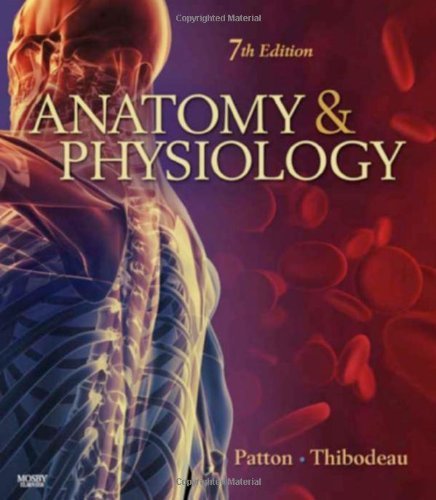Test Bank For Anatomy And Physiology 7th Edition By Patton Thibodeau
Original price was: $55.00.$25.00Current price is: $25.00.
The Test Bank for Anatomy and Physiology 6th Edition by Elaine N. Marieb provides instructors with a wide range of exam questions that cover all of the key concepts in the book. The test bank includes multiple-choice, short-answer, and essay questions that are carefully crafted to help students master the material.
In addition, the test bank includes an answer key that provides detailed explanations for each question. The Test Bank for Anatomy and Physiology 6th Edition by Elaine N. Marieb is a valuable resource for any instructor who is teaching this course.
Digital item No Waiting Time Instant Download
ISBN-10: 032305529X ISBN-13: 978-0323055291
Description
Test Bank For Anatomy And Physiology 7th Edition By Patton Thibodeau
Patton and Thibodeau: Anatomy & Physiology, 7th Edition
Chapter 2: The Chemical Basis of Life
Test Bank
TRUE/FALSE
1. Biochemistry deals with the chemical makeup of living organisms and the underlying process of life activities.
ANS: T DIF: Memorization REF: Page 34
TOP: Introduction
2.The number of protons in the nucleus of an atom determines its atomic mass.
ANS: F DIF: Memorization REF: Page 36
TOP:Atomic Number and Atomic Weight
3.The positively charged electrons are found in clouds outside the nucleus of an atom.
ANS: F DIF: Memorization REF: Page 36
TOP:Atomic Structure
4.Two shared pairs of electrons represent a single covalent bond.
ANS: F DIF: Application REF: Page 39 TOP: Covalent Bonds
5.The digestion of food is an example of a decomposition reaction.
ANS:TDIF:ApplicationREF:Page 40
TOP:Chemical Reactions
6.The number and arrangement of electrons orbiting in an atom’s outer shell determine its chemical activity.
ANS: T DIF: Application REF: Page 37 TOP: Energy Levels
7.An atom is chemically inert if its outermost shell has two pairs of electrons.
ANS: F DIF: Application REF: Page 37 TOP: Energy Levels
8.An isotope of an element contains the same number of neutrons but different numbers of protons.
ANS: F DIF: Memorization REF: Page 37
TOP: Isotopes
9.Electrovalent and ionic bonds are the same.
ANS: T DIF: Memorization REF: Page 38
TOP: Ionic Bonds
10.Radiation results from the breaking apart of the nucleus of an atom.
ANS: T DIF: Memorization REF: Page 38
TOP:Radioactivity
11.Radioactivity can cause an atom of one element to change to that of another element.
ANS: T DIF: Memorization REF: Page 38
TOP:Radioactivity
12.Ionizing radiation can be cancer-producing.
ANS: T DIF: Memorization REF: Page 38
TOP:Radioactivity
13.A substance that resists changes in pH when acids or bases are added is called a buffer.
ANS: T DIF: Application REF: Page 45 TOP: Buffers
14.The chemical reaction of an acid with a base always produces a salt and water.
ANS: T DIF: Application REF: Page 45 TOP: Salts
15.Water is the universal solvent.
ANS: T DIF: Memorization REF: Page 43
TOP: Water
16.Electrolytes include acids, bases, and salts.
ANS: T DIF: Memorization REF: Page 44
TOP: Electrolytes
17.All inorganic substances are free from carbon.
ANS: F DIF: Memorization REF: Page 42
TOP: Organic and Inorganic Compounds
18.Electrolytes are characterized by having either a positive or a negative charge.
ANS: T DIF: Memorization REF: Page 44
TOP: Electrolytes
19.Acids are electrolytes that produce OH+ ions.
ANS: F DIF: Memorization REF: Page 44
TOP: Acids
20.pH stands for the negative logarithm of the hydrogen ion concentration.
ANS: T DIF: Memorization REF: Page 44
TOP:The pH Scale
21.Proteins are the most abundant of the carbon-containing compounds in the body.
ANS: T DIF: Memorization REF: Page 52
TOP: Proteins
22.Glycogen and starch are both examples of polysaccharides.
ANS: T DIF: Memorization REF: Page 48
TOP: Disaccharides and Polysaccharides
23.There are a total of 20 essential amino acids.
ANS: F DIF: Memorization REF: Page 52
TOP:Amino Acids
24.Steroids are often called tissue hormones.
ANS: F DIF: Synthesis REF: Page 50 TOP: Steroids
25.DNA molecules are the largest molecules in the body.
ANS: T DIF: Memorization REF: Page 57
TOP:Nucleic Acids
26.Adenine and thymine are referred to as purine bases, which are important constituents of a DNA molecule.
ANS: F DIF: Memorization REF: Page 57
TOP:Nucleic Acids
27.Metabolism includes the processes of both anabolism and catabolism.
ANS: T DIF: Memorization REF: Page 41
TOP: Metabolism
28.The ability of proteins to perform their function depends on their shape.
ANS:TDIF:ApplicationREF:Page 56
TOP: Levels of Protein Structure
29.Enzymes are proteins that function by the lock-and-key theory.
ANS:TDIF:SynthesisREF:Page 56
TOP: Levels of Protein Structure
30.ATP is broken down in an anabolic reaction.
ANS: F DIF: Application REF: Page 41 TOP: Catabolism
31.Catabolism and anabolism are major types of metabolic activity.
ANS: T DIF: Memorization REF: Page 41
TOP: Metabolism
32.Sodium chloride is an example of an ionic bond.
ANS: T DIF: Application REF: Page 38 TOP: Ionic Bonds
33.The digestion of food is an example of a synthesis reaction.
ANS:FDIF:SynthesisREF:Page 40 | Page 41
TOP:Chemical Reactions
34.The pH scale indicates the degree of acidity or alkalinity of a solution.
ANS: T DIF: Memorization REF: Page 44
TOP:Acids and Bases
35.Litmus paper will turn red in the presence of a base.
ANS: F DIF: Memorization REF: Page 44
TOP:Acids and Bases
36.High-density lipoprotein (HDL) is also called the “bad” cholesterol.
ANS:FDIF:ApplicationREF:Page 51 (Box 2-2)
TOP:Blood Lipoproteins
37.The nonessential amino acids cannot be produced from the other amino acids or from simple organic molecules.
ANS: F DIF: Memorization REF: Page 52
TOP:Amino Acids
38.The atomic weight of an atom is equal to the number of protons plus the number of neutrons.
ANS: T DIF: Memorization REF: Page 36
TOP:Atomic Number and Atomic Weight
39.The mass of a proton is almost exactly equal to the mass of an electron.
ANS: F DIF: Memorization REF: Page 33
TOP:Atomic Number and Atomic Weight
40.Hydrogen will react with other atoms to get 8 electrons in its outer energy level.
ANS: F DIF: Application REF: Page 37 TOP: Energy Levels





Be the first to review “Test Bank For Anatomy And Physiology 7th Edition By Patton Thibodeau”